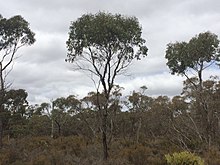
Eucalyptus accedens, commonly known as smooth bark wandoo or powderbark wandoo is a species of tree endemic to the south-west of Western Australia. Although the common names suggest it is similar to wandoo,, the two species are very different botanically. The bark of E. accedens has talc-like powder, at least on the protected side of the trunk and the tree usually grows on laterite in higher places.

Eucalyptus eremophila, commonly known as the sand mallet or tall sand mallee, is a species of mallet that is endemic to semi-arid regions of Western Australia. It has smooth pale brown and greyish bark, narrow lance-shaped to elliptical adult leaves, flower buds arranged in groups of between seven and eleven with an elongated operculum, and cup-shaped to barrel-shaped fruit.

Eucalyptus macrandra, commonly known as long-flowered marlock, river yate or twet, is a species of mallee or small tree that is endemic to the south-west of Western Australia. It has smooth greyish bark, lance-shaped adult leaves, flower buds usually in groups of fifteen, pale yellow flowers and elongated cup-shaped to bell-shaped fruits.

Eucalyptus cornuta, commonly known as yate, is a tree species, sometimes a mallee and is endemic to the southwest of Western Australia. It has rough, fibrous bark on all or most of its trunk, smooth bark above, mostly lance-shaped adult leaves, elongated flower buds in groups of eleven or more, yellowish flowers and cylindrical to cup-shaped fruit. It is widely cultivated and produces one of the hardest and strongest timbers in the world.

Eucalyptus rudis, commonly known as flooded gum or moitch, is a species of small to medium-sized tree endemic to coastal areas near Perth, Western Australia. The Noongar names for the tree are colaille, gooloorto, koolert and moitch. This tree has rough, fibrous bark on the trunk and large branches, smooth greyish bark above, lance-shaped to curved adult leaves, flower buds in groups of between seven and eleven, white flowers and bell-shaped, cup-shaped or hemispherical fruit.

Eucalyptus oleosa, commonly known as the red mallee, glossy-leaved red mallee, acorn mallee, oil mallee or giant mallee, is a tree or mallee that is native to Australia. The leaves were once harvested for the production of cineole based eucalyptus oil. Eucalyptus cneorifolia is now the predominant strain used in production due to a higher oil content in new growth.

Eucalyptus salmonophloia, commonly known as salmon gum, wurak or weerluk, is a species of small to medium-sized tree that is endemic to Western Australia. It has smooth bark, narrow lance-shaped to curved adult leaves, flower buds in groups of between nine and thirteen, creamy white flowers and hemispherical fruit.

Eucalyptus megacornuta, also known as warted yate or warty yate, is a species of Eucalyptus that is endemic to the south-west of Western Australia.

Eucalyptus spathulata, commonly known as swamp mallet, narrow leaved gimlet or swamp gimlet, is a species of mallet that is endemic to Western Australia. It has a dense crown, smooth, satin-like bark, glossy green, linear leaves, flower buds in groups of three or seven, white flowers and cup-shaped to conical fruit.

Melaleuca teretifolia is a plant in the myrtle family, Myrtaceae, which is endemic to the south-west of Western Australia. It is a shrub with long, thin leaves and clusters of usually white flowers along considerable lengths of the branches in late spring and summer.

Eucalyptus astringens, commonly known as brown mallet or to Noongar people as mallat, woonert or wurnert, is a tree that is endemic to the South West region of Western Australia. It has smooth, shiny bark on its trunk and branches, lance-shaped leaves, pendulous flower buds arranged in groups of seven, cream-coloured to pale lemon-coloured flowers and cup-shaped to bell-shaped or conical fruit. This tree has also been introduced to Victoria.
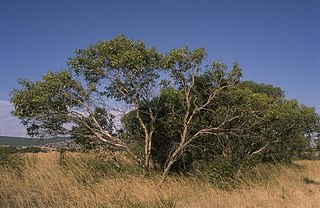
Eucalyptus incrassata, commonly known as the lerp mallee, yellow mallee, ridge fruited mallee or rib fruited mallee, is a species of mallee that is endemic to southern Australia. It has smooth bark, sometimes with rough, ribbony bark near the base, lance-shaped adult leaves, flower buds in groups of seven, creamy white, pale yellow, sometimes pink or red flowers, and cylindrical, barrel-shaped or bell-shaped fruit.
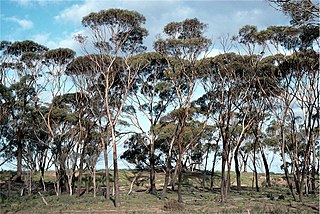
Eucalyptus kondininensis, commonly known as Kondinin blackbutt, is a species of tree that is endemic to Western Australia. It has rough, black bark on the trunk, smooth grey to white bark on the branches, lance-shaped adult leaves, flower buds in groups of seven, white flowers and cup-shaped to conical fruit.

Eucalyptus longicornis, commonly known as red morrel, morryl, poot or pu, is a species of large tree that is endemic to the south-west of Western Australia. It has rough, fibrous, fissured bark on the trunk, smooth greyish bark above, flower buds in groups of seven or more, white flowers and shortened spherical fruit.

Eucalyptus myriadena, also known as blackbutt, is a species of mallee or tree that is native to Western Australia. It has rough, coarse flaky bark on part of the trunk, smooth bark above, linear to narrow lance-shaped adult leaves, flower buds in groups of between nine and thirteen, white flowers and narrow cylindrical to barrel-shaped fruit. It is widely distributed in the wheatbelt and goldfield areas of the state.

Acacia huegelii is a shrub belonging to the genus Acacia and the subgenus Phyllodineae native to Western Australia.
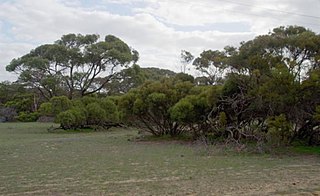
Eucalyptus decipiens, commonly known as redheart or redheart moit is a species of mallee or small tree that is endemic to Western Australia. It has varying amounts of rough, imperfectly shed ribbons of brownish bark and smooth whitish to grey bark, lance-shaped adult leaves, flower buds in groups of between eleven and twenty one, and conical to flattened hemispherical fruit.
Eucalyptus moderata is a species of tree or a mallee that is endemic to the southwest of Western Australia. It has rough, hard, fibrous bark on some or all of the trunk, lance-shaped adult leaves, flower buds usually in groups of seven, pale yellow flowers and pendulous, urn-shaped fruit.

Lake Towerrinning or Towerrinning Lake is a permanent brackish lake in the Wheatbelt region of Western Australia located approximately 32 km (20 mi) south of Darkan, 44 km (27 mi) south west of Wagin and about 245 km (152 mi) south east of Perth. The lake is managed by the Department of Parks and Wildlife since it is used as a recreational facility; the Shire of West Arthur leases part of it as a gazetted water ski area.
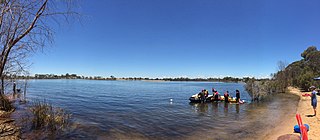
Lake Nunijup is an ephemeral salt lake located in the Great Southern region of Western Australia, approximately 27 km (17 mi) south west of Cranbrook and 41 km (25 mi) north west of Mount Barker.
